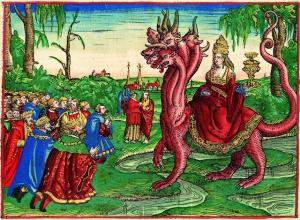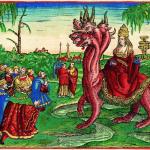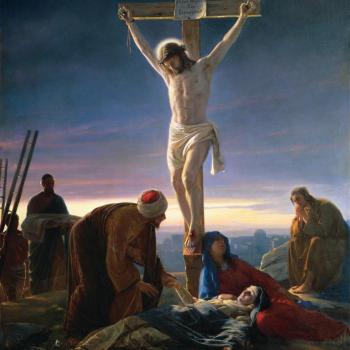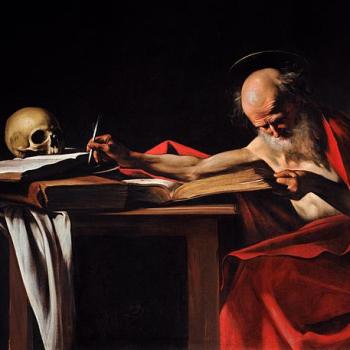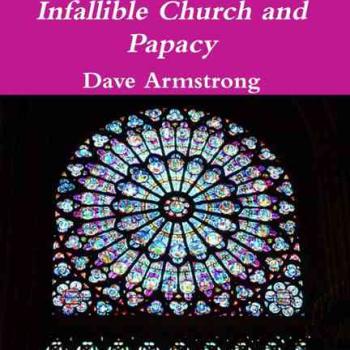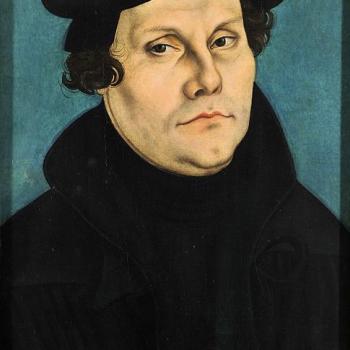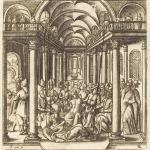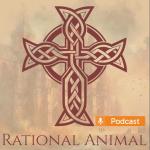St. Vincent Lerins & Development; Catholicism & Suicide; Subjective Mortal Sin; Immaculate Conception: Necessary or “Fitting”?; Catholic Converts & Philosophers; Spiritual Experiences; Holy Church in Scripture
The late Steve Hays (1959-2020) was a Calvinist (and anti-Catholic) apologist, who was very active on his blog, called Triablogue (now continued by Jason Engwer). His 695-page self-published book, Catholicism — a collection of articles from his site — has graciously been made available for free. On 9 September 2006, Hays was quite — almost extraordinarily — charitable towards me. He wrote then:
I don’t think I’ve ever accused him of being a traitor or apostate or infidel. . . . I have nothing to say, one way or the other, regarding his state of grace. But his sincerity is unquestionable. I also don’t dislike him. . . . I don’t think there’s anything malicious about Armstrong—unlike some people who come to mind. In addition, I don’t think I’ve ever said he was unintelligent. For the record, it’s obvious that Armstrong has a quick, nimble mind.
Two-and-a-half years later, starting in April 2009 and up through December 2011 (in the following quotations) his opinion radically changed, and he claimed that I have “an evil character,” am “actually evil,” “ego-maniac, narcissist,” “idolater,” “self-idolater,” “hack who pretends to be a professional apologist,” given to “chicanery,” one who doesn’t “do any real research,” “a stalwart enemy of the faith . . . no better than [the atheists] Richard Dawkins or Christopher Hitchens,” with an intent to “destroy faith in God’s word,” “schizophrenic,” “emotionally unhinged,” one who “doesn’t trust in the merit of Christ alone for salvation,” “has no peace of mind,” “a bipolar solipsist,” “split-personality,” and a “bad” man. He wasn’t one to mince words! See more gory details.
I feel no need whatsoever to reciprocate these silly and sinful insults. I just wanted the record to be known. I’ve always maintained that Hays was a very intelligent man, but habitually a sophist in methodology; sincere and well-meaning, but tragically and systematically wrong and misguided regarding Catholicism. That’s what I’m addressing, not the state of his heart and soul (let alone his eternal destiny). It’s a theological discussion. This is one of many planned critiques of his book (see my reasons why I decided to do this). Rather than list them all here, interested readers are directed to the “Steve Hays” section of my Anti-Catholicism web page, where they will all be listed. My Bible citations are from the RSV. Steve’s words will be in blue.
*****
[Chapter 5: Convert Syndrome]
To be deep in history is to cease to be a Protestant
[H]e [Cardinal Newman] rejects the Vincentian canon. He repudiates the threefold criterion of catholicity as a hyperbolic idealization. It’s quite ironic that the man who said “To be deep in history is to cease to be a Protestant” is the very same man whose appeal to historical theology flunks the triple test of antiquity, unanimity, and ecumenicity. Moral of the story: a Catholic convert or apologist has to choose between two divergent slogans: “To be deep in history is to cease to be a Protestant” or “What has been believed everywhere, always, and by all”, for Vincentian continuity is antithetical to the theory of development. [p. 194]
Here Hays reveals his profound, stupefied ignorance of development of doctrine: both its nature and the fact that Vincent of Lerins was undeniably the very Church father who wrote the most explicitly about — and in favor of — development of doctrine (in his Commonitorium). He didn’t see it as contrary to his dictum at all. He held both concepts together in harmony, in this one work of his. So did St. Cardinal Newman, and so does the Catholic Church. Protestant Church historian Philip Schaff wrote along these lines:
Augustin admits the idea of historical development or a gradual progress from a lower to higher grades of knowledge, yet always in harmony with Catholic truth. He would not allow revolutions and radical changes or different types of Christianity. “The best thinking” (says Dr. Flint, in his Philosophy of History in Europe, I. 40), “at once the most judicious and liberal, among those who are called the Christian fathers, on the subject of the progress of Christianity as an organization and system, is that of St. Augustin, as elaborated and applied by Vincent of Lerins in his ‘Commonitorium,’ where we find substantially the same conception of the development of the Church and Christian doctrine, which, within the present century, De Maistre has made celebrated in France, Mohler in Germany, and Newman in England.” (Editor’s Preface to City of God, 38-volume set of the Church Fathers, 10 December 1886)
Not that Vincent is a conservative who excludes the possibility of all progress in doctrine. In the first place, he admits that it has been the business of councils to perfect and polish the traditional formulae, and even concepts, in which the great truths contained in the original deposit are expressed, thereby declaring ‘not new doctrines, but old ones in new terms’ (non nova, sed nove). Secondly, however, he would seem to allow for an organic development of doctrine analogous to the growth of the human body from infancy to age. But this development, he is careful to explain, while real, must not result in the least alteration to the original significance of the doctrine concerned. Thus in the end the Christian must, like Timothy [1 Timothy 6:20] ‘guard the deposit’, i.e., the revelation enshrined in its completeness in Holy Scripture and correctly interpreted in the Church’s unerring tradition. (Early Christian Doctrines, HarperSanFrancisco: revised edition of 1978, 50-51)
St. Vincent stated:
The growth of religion in the soul must be analogous to the growth of the body, which, though in process of years it is developed and attains its full size, yet remains still the same. There is a wide difference between the flower of youth and the maturity of age; yet they who were once young are still the same now that they have become old, insomuch that though the stature and outward form of the individual are changed, yet his nature is one and the same, his person is one and the same. (Commonitorium, XXIII)
Weathercock apologetics
To take another example, traditionally, suicide was treated as a damnatory sin. According to the Baltimore Catechism: “It is a mortal sin to destroy one’s own life or commit suicide, as this act is called, and persons who willfully and knowingly commit such an act die in a state of mortal sin and are deprived of Christian burial.” [this is from some version after 1885. It’s not in the original version]
But the post-Vatican II Catechism of the Catholic Church introduces eventuating circumstances that mitigate the guilt of suicide. [p. 195]
The original 1885 version of the Baltimore Catechism delineated the difference between mortal and venial sin:
54. Q. What is mortal sin? A. Mortal sin is a grievous offense against the law of God.
57. Q. What is venial sin? A. Venial sin is a slight offense against the law of God in matters of less importance; or in matters of great importance it is an offense committed without sufficient reflection or full consent of the will. (Baltimore Catechism No. 1, 1885)
Note that there are three elements required for one to be personally or subjectively (as Catholics say) guilty of mortal sin:
1) a matter of “great importance” (or what we usually call “grave matter”),
2) “sufficient reflection,”
and
3) “full consent of the will.”
Failing any or all of those, the sin is not subjectively mortal. Suicide in and of itself (as a species of murder) is an objectively mortal sin, but a person may not be subjectively guilty: the type of deeper sin and guilt that places them in danger of separation from God and indeed eternal hellfire.
In other words, there was always this understanding of mortal and venial sin in Catholicism, and thus, it’s too simplistic to say that Church taught or teaches that “anyone who commits suicide goes to hell.” That was true in 1885 Catholicism and is just as true today. There simply is no contradiction, as Hays vainly wished and/or mistakenly thought was the case. Hays claimed that the new Catechism “introduces” these distinctions that I just explained. This is the sort of sophistry and (deliberate or not) intellectual dishonesty that he constantly exhibited. The Catechism of the Catholic Church stated:
2282 . . . Grave psychological disturbances, anguish, or grave fear of hardship, suffering, or torture can diminish the responsibility of the one committing suicide.
2283 We should not despair of the eternal salvation of persons who have taken their own lives. By ways known to him alone, God can provide the opportunity for salutary repentance. The Church prays for persons who have taken their own lives.
#2282 outlines the sort of thing that would reduce this sin from subjectively mortal to venial. It simply goes into more depth than the old Catechism, but doesn’t contradict it. If someone is suffering from “grave psychological disturbances” or “anguish” or “grave fear of hardship” or “torture” etc., then it can cause them to act contrary to the full consent of their will and sufficient reflection on what they are doing. Either of those things “diminishes” their “responsibility” and hence the necessity of being damned for mortal sin.
Accordingly, the Baltimore Catechism used the description of a person “willfully and knowingly” committing this sin. That refers to “full consent of the will” and “sufficient reflection” which would cause them to die in a state of mortal sin. But failing these things, they do not die in subjective mortal sin, and there is hope for their salvation (noted by the new Catechism in #2283).
Again, nothing whatsoever has changed. If Hays wanted to argue that venial and mortal sin was some new concept at Vatican II, he was free to do that. That’s the only way I can see that he could have plausibly charged “reversal of doctrine!” Otherwise, this is a bunch of hot air and unworthy and erroneous, ignorant speculation.
Bryan’s stalled chess game
If the mother of Jesus must be immaculately conceived so that she doesn’t transmit original sin to Jesus, then the same principle applies to the mother of Mary, and Mary’s grandmother, and great-grandmother, &c. [p. 211]
But this is not Catholic teaching, which holds that Mary’s Immaculate Conception was not necessary per se, but rather, “fitting.” God performed an act of special and unique grace at her conception that had nothing whatsoever to do with her mother or grandmother or father. See my papers:
Mary’s Immaculate Conception: Necessary or “Fitting”? [12-8-17]
Conversely, if God can simply intervene to prevent the transmission of original sin, then Mary’s immaculate conception is superfluous, [p. 211]
Nothing God does is “superfluous.” He deemed it appropriate and fitting that the Mother of God the Son was freed from all actual and original sin. He simply made her the “New Eve” by His grace.
because God could skip over Mary by to intervene one step further down the line at the conception of Jesus. [p. 211]
Sure, He could have. He could have done many different things. He could have created life on Mars instead of earth. But this is what He did, and as a result, the angel Gabriel said to Mary: “Hail, full of grace.”
Short of divine revelation, how would anyone be in a position to know that Mary was immaculately conceived? Where’s the evidence that such a revelation was ever given? [p. 211]
Luke 1:28 and the use of the word kecharitomene (“full of grace” contains the essence of the doctrine (Mary’s sinlessness). Scriptural analogies include many others who were sanctified in the womb (e.g., Jeremiah and John the Baptist).
To whom? [p. 211]
St. Luke. Pious reflection and development through the centuries brought about the compete doctrine
To all appearances, the immaculate conception is a legend that hardened into dogma. [p. 211]
Biblical revelation isn’t “legend.” Nor is legitimate doctrinal development the “harden[ing]” of legend. Hays is looking at the wrong topic. Sola Scriptura and sola fide are the legends that are completely absent from Scripture; hence, not based on revelation but rather, arbitrary extrabiblical traditions of men. Martin Luther only adopted sola Scriptura as a desperate ploy or last resort, having been backed into it by the rigors of a formal debate: the Leipzig Disputation of 1519.
[T]he immaculate conception . . . [is] not based on good historical evidence but raw church authority. Indeed, an ecclesiastical fiat is a necessary makeweight to compensate for the lack of credible historical evidence. [p. 214]
The visitation of Mary by the angel Gabriel is historical, and it happened in Nazareth. We know this from revelation (Luke 1:28). Sola Scriptura is not based on good biblical evidence but rather, arbitrary Protestant rejection of the infallibility of apostolic tradition and Church authority. Indeed, Martin Luther’s desperation and being caught on “the horns of a dilemma” in a debate in 1519 was a necessary makeweight to compensate for the lack of credible biblical evidence.
The less and the lightest
Even assuming that these are the best and the brightest, we have to examine the arguments. [p. 215]
Why didn’t Hays do that, then? I haven’t seen him examine even one conversion testimony in depth, point-by-point. He mentioned Surprised by Truth: the 1994 bestseller edited by Patrick Madrid that contained eleven conversion stories, including my own. But he didn’t take on even one of them. He simply fired potshots from the woods and then scurried deeper into the woods and to the hills, lest he be subject to devastating counter-replies. This was his constant pathetic method.
Aren’t conversion stories to Catholicism pretty much interchangeable? [p. 215]
No. Quite the contrary.
To my knowledge, Reformed seminaries don’t generally have courses on how to respond to Catholic apologetics. [p. 215]
I guess not, judging by the pathetic counter-“arguments” offered up, even by anti-Catholicism’s “best and brightest” like James White, James Swan, Eric Svendsen, Jason Engwer, and Steve Hays. So that explains it . . .
Peter Geach and Elizabeth Anscombe were two of the very brightest converts, but I don’t think either one ever made a sustained case for Roman Catholicism. [p. 215]
Precisely because they were philosophers, not apologists. They don’t necessarily have to do that, nor should we expect them to. They might have done it, though, had they chosen that course. Hays conveniently neglects Peter Kreeft, one of the most brilliant Catholic apologists of our time, who extensively defends Catholicism and writes apologetics. He’s a professional philosopher. Hays mentions him derisively on p. 236 and claims that he “recycle[s] all the boilerplate arguments you encounter in Catholic apologists who are not trained philosophers.” Again on page 244, he writes condescendingly, “Does Kreeft bother to do the most rudimentary research?”
This is typical of Hays’ non-substantive, utterly non-comprehensive, surfacey, unserious treatments of anyone he disagreed with. Kreeft has written more than 78 books of apologetics, including defenses of Catholicism. Hays going after him in a juvenile, patronizing fashion is a bit like trying to overcome a tank with a squirt gun.
Hays mentions Francis Beckwith, another philosopher who has written some apologetics, 14 times in his book, and he gets the same snobbish, petulant, superficial treatment; for example, “Francis Beckwith is fond of these cute little quips. But they’re intellectually shallow” (p. 461). Such a description is far more applicable to Hays himself. Projection, methinks?
Alexander Pruss is arguably the smartest Catholic philosopher of his generation, but while he sometimes toys with ingenuous defenses of Transubstantion [sic], I haven’t seen him defend Catholicism in general. [p. 215]
He’s under no obligation to do so, being a philosopher. The people who do this — and can be reasonably expected to do so — are professional Catholic apologists like myself (I have over 4,300 articles online, and have authored or edited 51 books, including over twenty with “real” publishers, unlike Hays). But Hays had no time to seriously interact with my work (though he rather warmly complimented me at first).
Bas van Fraassen is a brilliant philosopher of science who takes some inept potshots at sola Scriptura in one of his books, but that’s about it. Copleston debated Ayer and Russell on God’s existence, but despite his prolific outlook I don’t recall his writing a book or essay in defense of Roman Catholicism. Indeed, towards the end of his life he was quite skeptical. [p. 215]
Ditto to my previous responses. This is just silly. As an apologist who devotes himself to such things, I wrote two books about sola Scriptura alone (both published in 2012). I didn’t see Hays ever interact with those. If he wanted vigorous, in-depth argumentation on that important topic of contention, I certainly offered it (agree or disagree). But Hays had no interest in actual serious dialogue and interaction with opposing viewpoints. By then, he was too busy characterizing me as an “an evil character,” “ego-maniac, narcissist,” “self-idolater,” “hack who pretends to be a professional apologist,” “schizophrenic,” “emotionally unhinged,” etc.
While not in the same league as Pruss, Ed Feser is a very smart convert. But to my knowledge, Feser spends most of his time defending Thomism. [p. 216]
Since Thomism is a respectable Catholic position, then this is a Catholic philosopher doing Catholic apologetics. Even when Hays discovers an example of this, he finds an absurd way to deride it. This would be like contending, “Hays is a very smart Protestant. But to my knowledge, he spends most of his time defending Calvinism.” Is that not still Protestant apologetics? Of course it is (Calvinism being a species of Protestantism). It’s just one particular brand. Folks can’t do everything. They usually specialize.
The brightest Catholic Bible scholars like Raymond Brown, Joseph Fitzmyer, John Meier, and John Collins subvert traditional Catholic positions. [p. 216]
This exactly verifies a criticism I made in one of the earlier replies. At least he was honest about it in this instance. Hays classifies Catholic dissidents as the “brightest Catholic Bible scholars.” This is the cynical, wrongheaded, fatuous game that he constantly played. He couldn’t bring himself to classify orthodox Catholic scholars in such a way. They get the treatment that he gave Peter Kreeft, or Scott Hahn, who is mentioned only once in the book and put down, along with G. K. Chesterton, Thomas Merton, Malcolm Muggeridge, Richard John Neuhaus, Frank Sheed, Adrienne von Speyr, and Evelyn Waugh, as “Popularizers. Retail salesmen rather than wholesale thinkers” (p. 181). Hays was, sad to say, almost perpetually a pompous ass.
I myself was put in the same boat as Scott Hahn (I’m honored!) and caricatured and put down by Hays in a hit piece dated 9-14-06:
[M]any Evangelical immigrants to Rome bring along a certain amount of contraband theology stashed away in their luggage. As I’ve observed in the past, they are often far more conservative than cradle Catholics or the clergy. Indeed, they’re often at odds with their adopted denomination. So guys like Dave Armstrong and Scott Hahn present an artificially Evangelicalized version of Roman Catholicism. . . . they end up with a sterile hybrid theology that isn’t consistently Catholic or Protestant.
Hays wrote in the combox about Scott Hahn:
At this point I don’t remember what all I have or have not read of Hahn. But I don’t read Catholic popularizers and lay apologetes to learn about Catholic theology. I read them to study the bad arguments for Catholicism.
He did another ridiculous comparison of myself and Scott Hahn and indulged in fantastic flights of fancy in a post dated 5-12-05:
Hahn and Armstrong . . . [are] trying to carve out a little niche within the church. Theirs is a church within the church. This is not Roman Catholicism, but an inner schism–a homegrown chapel within the Church of Rome. . . .
There’s quite a difference between a group which pays lip-service to the magisterium while going its own way, and one that publicly defies the magisterium. My allegation is that Armstrong is schismatic in the first sense, not the second.
Hays attacked and caricatured Scott Hahn again on 5-26-07:
If there’s one word to summarize his method, it’s “equivocation.” He often engages in prooftexting, but the actual meaning of the text always falls short of what he needs it to mean, which is why he then takes refuge in the church fathers—which is not to say that his use of the church fathers is necessarily any better. . . . we need to keep our eye on the constant gear-shifting, as he goes from what the Bible really says to his idiosyncratic interpretations and fallacious inferences. . . .
[H]is characterization of Roman Catholicism is utterly tendentious. . . . Hahn mouths a lot of formulaic phrases without given any thought to the nonsense he’s mouthing. . . .
A reader who relied on Hahn for his knowledge of Catholicism would have no idea what a skewed picture he’s getting. Hahn poses as a representative of Catholic dogma, but his exegetical argumentation is hardly representative of mainstream Catholicism. . . . a retrograde convert and soapbox polemicist . . .
And here’s another typical Hays attack on yours truly (dated 7-19-04):
Every now and then I tune into Dave Armstrong’s RC website to see what’s new, if anything, in this alternative universe. . . . In a sense, then, Armstrong and his cobelligerents have never really converted to Catholicism at all. Instead, they’ve founded their own little private Victorian Catholic cult, with Newman, Knox, Belloc, Chesterton, and Tolkien as their patron saints–whereas the real Roman Catholicism is represented by the likes of Rahner and Raymond Brown. Theirs is not official Catholicism, but a treehouse for child actors. This is Oreo cookie Catholicism–Popish on the outside, but schismatic on the inside.
Hays attacked Hahn and Karl Keating as “fluffy, bantamweight popularizers” on 8-8-08. On 8-24-08, I was lumped in with Keating, and Hays described us as “Internet popes . . . These are Catholics who don’t’ even study Catholic scholarship. Part of the problem is that a lot of Catholic laymen aren’t intellectuals. So they don’t read serious historical or exegetical literature. They only read popularizers. Or watch EWTN.”
He attacks Catholic apologist Bryan Cross (even after doing quite a bit of analysis of his arguments), saying, “Bryan’s theological method is a priori and ahistorical rather than exegetical. Bryan is in love with his own mind.” [p. 235]
Bishop Robert Barron, no mean apologist, in addition to his theological education, earned a Master’s Degree in philosophy. Does that cause Hays to give him any credit in this book, and treat him with rudimentary respect? No:
Barron is an eloquent, seductive mythmaker. His biblical prooftexts for Catholicism detach the text from the original meaning, and reattachment it to “development”. Once theology is cut off from the sacred text, it takes on a life of its own, in ever-bolder flights of fantasy. The exercise has a snowball effect, as seminal errors accumulate and magnify. No longer constrained by the reality of revelation, it goes wherever imagination takes it. In some ways, Barron’s book is a throwback to Chateaubriand’s The Genius of Christianity. An apologetic heavy on aesthetics. Catholicism is too pretty not to be true! [p. 59]
***
Newman is an exception, but an ironic exception. Newman didn’t really convert to Roman Catholicism. Rather, Newman converted (or subverted) Roman Catholicism to himself. He redefined tradition to bend Catholicism to his own predilections. He changed the thing he converted to, so that Newman’s Catholicism is Newman’s face in the mirror. [p. 216]
Right. This is merely stupid, clueless, and idiotic, and deserves no further response. Heaven help my patience. It’s hanging by a string at this point.
Turning to Catholicism–1
It isn’t necessary for Christians to get it all right in this life–because this life isn’t all there is. I can make innocent mistakes in this life which will be rectified in the world to come. [p. 220]
This is an excellent argument for purgatory!
Turning to Catholicism–2
[S]ome of the contributors find the doctrine of the real presence to be emotionally compelling. At that level, there’s nothing to refute because it
isn’t based on reason, evidence, or exegesis, but felt-needs. [p. 236]
Oh, you mean like John Calvin’s rationale for believing in Holy Scripture, which is likewise not “based on reason, evidence, or exegesis”?:
Let this point therefore stand: those whom the Holy Spirit has inwardly taught truly rest upon Scripture, and that Scripture indeed is self-authenticated; hence it is not right to subject it to proof and reasoning. And the certainty it deserves with us, it attains by the testimony of the Spirit. For even if it wins reverence for itself by its own majesty, it seriously affects us only when it is sealed upon our hearts through the Spirit. Therefore, illumined by his power, we believe neither by our own nor by anyone else’s judgment that Scripture is from God; but above human judgment we affirm with utter certainty (just as if we were gazing upon the majesty of God himself) that it has flowed to us from the very mouth of God by the ministry of men. We seek no proofs, no marks of genuineness upon which our judgment may lean; but we subject our judgment and wit to it as to a thing far beyond any guesswork! (Institutes of the Christian Religion, I. vii. 1, 2, 5, John T. McNeill, ed., trans. Ford Lewis Battles, Philadelphia: Westminster Press)
Turning to Catholicism-5
Catholics have a schizoid ecclesiology. They bifurcate “the Church” into two divergent churches: on the one hand is the church that does all the bad stuff. The church with all the corruption, contradictions, and blunders. On the other hand is the spotless Bride of Christ. The pure, indefectible, infallible church. [p. 242]
The Bible has a schizoid ecclesiology. It bifurcates “the Church” into two divergent churches: on the one hand is the church that does all the bad stuff. The church with all the corruption, contradictions, and blunders. On the other hand is the spotless Bride of Christ. The pure, indefectible, infallible church:
A straightforward reading of Paul’s chastisement of the Corinthians lends itself to the view that problems were massive: definitely a majority of the believers there, if not a near-unanimity. This church had some heavy-duty problems!:
1) His rebuke concerning their divisiveness (1 Cor 3:1-4) seems to be directed at the group as a whole, not just a few.
2) The incest spoken of in 1 Corinthians 5:1-2 was of one man, yet the whole body is rebuked for not having “mourn[ed]” that, and for failing to “remove” the incorrigible sinner.
3) Likewise concerning bringing lawsuits into the secular arena. Paul says, “Can it be that there is no man among you wise enough to decide between members of the brotherhood . . .?” (1 Cor 6:5).
4) Likewise with divisions and abuses of the Lord’s Supper (“each one”: 1 Cor 11:21). This is a general rebuke, directed towards practically all the members, not a dissenting minority.
5) Finally, in 2 Corinthians 11:4, Paul speaks of the church as a whole being prone to chasing after false teachers. This leads him into his famous “boasting” discourse. He is touting his own qualifications as an Apostle so that they won’t go running after false apostles and deceivers, and will keep to the true path (2 Cor 12:20-21).
Jesus Himself rebukes six of the seven churches of Asia He addresses. Most scholars think that the Book of Revelation was written no later than AD 100. Yet look at all the serious problems already observed in these apostolic churches!
The parable of the wheat and tares (Mt 13:24-30, 36-43) reads as if the tares (weeds) are at least equal in number to the wheat. A moment’s reflection on the proliferation of uncontrolled weeds (13:30) in any lawn will bring this point home, I think. This is also apparent in the similar pronouncements about wheat and chaff (Mt 3:12; Lk 3:17): a parable of the saved and the damned. Since every wheat plant has chaff, too (the worthless part of it), then it would seem that we are talking about a 50/50 proposition.
The Apostle Paul has very stern words for the Galatian church as well. None of these congregations “had it all together” spiritually (not even close), as many today seem to arrogantly believe about their own particular fellowships. Again, nothing has changed. The Puritan notion of a “pure” church or denomination is a myth if ever there was one. And it is unbiblical, if the examples of apostolic churches prove anything.
1) “I am astonished that you are so quickly deserting him who called you in the grace of Christ and turning to a different gospel.” (Gal 1:6)
2) “O foolish Galatians! Who has bewitched you, before whose eyes Jesus Christ was publicly portrayed as crucified? . . . Are you so foolish? Having begun with the Spirit, are you now ending with the flesh?” (Gal 3:1, 3)
3) “but now that you have come to know God, or rather to be known by God, how can you turn back again to the weak and beggarly elemental spirits, whose slaves you want to be once more? . . . I am afraid I have labored over you in vain.” (Gal 4:9, 11)
4) “Have I then become your enemy by telling you the truth? . . . I am perplexed about you.” (Gal 4:16, 20)
5) “For freedom Christ has set us free; stand fast therefore, and do not submit again to a yoke of slavery. Now I, Paul, say to you that if you receive circumcision, Christ will be of no advantage to you. . . . You are severed from Christ, you who would be justified by the law; you have fallen away from grace.” (Gal 5:1-2, 4)
6) “You were running well; who hindered you from obeying the truth?” (Gal 5:7)
Yet the same Bible refers to a holy and infallible Church:
Ephesians 5:25-27 . . . Christ loved the church and gave himself up for her, that he might sanctify her, having cleansed her by the washing of water with the word, that he might present the church to himself in splendor, without spot or wrinkle or any such thing, that she might be holy and without blemish.
1 Corinthians 12:27 Now you are the body of Christ and individually members of it.
Acts 8:3; 9:1, 4-5 But Saul was ravaging the church, and entering house after house, he dragged off men and women and committed them to prison. . . . Saul, still breathing threats and murder against the disciples of the Lord. . . . And he fell to the ground and heard a voice saying to him, “Saul, Saul, why do you persecute me?” And he said, “Who are you, Lord?” And he said, “I am Jesus, whom you are persecuting”;
Matthew 16:18 . . . my church . . . [Jesus speaking]
Acts 20:28 . . . care for the church of God which he obtained with the blood of his own Son.
Acts 15:28 . . . it has seemed good to the Holy Spirit and to us . . . [i.e., “the apostles and the elders” (15:2) gathered in Jerusalem for a council or “assembly” (15:12)]
1 Timothy 3:15 . . . the household of God, which is the church of the living God, the pillar and bulwark of the truth.
Conclusion: by Hays’ “reasoning” the Bible (especially St. Paul) has a “schizoid ecclesiology”: just as us lowly ignorant Catholics supposedly do.
***
Practical Matters: Perhaps some of my 4,300+ free online articles (the most comprehensive “one-stop” Catholic apologetics site) or fifty-one books have helped you (by God’s grace) to decide to become Catholic or to return to the Church, or better understand some doctrines and why we believe them.
Or you may believe my work is worthy to support for the purpose of apologetics and evangelism in general. If so, please seriously consider a much-needed financial contribution. I’m always in need of more funds: especially monthly support. “The laborer is worthy of his wages” (1 Tim 5:18, NKJV). 1 December 2021 was my 20th anniversary as a full-time Catholic apologist, and February 2022 marked the 25th anniversary of my blog.
PayPal donations are the easiest: just send to my email address: apologistdave@gmail.com. You’ll see the term “Catholic Used Book Service”, which is my old side-business. To learn about the different methods of contributing, including 100% tax deduction, etc., see my page: About Catholic Apologist Dave Armstrong / Donation Information. Thanks a million from the bottom of my heart!
***
Photo credit: The Whore of Babylon (workshop of Lucas Cranach): colorized illustration from Martin Luther’s 1534 translation of the Bible [public domain / Wikimedia Commons]
***
Summary: The late Steve Hays was a Calvinist and anti-Catholic writer and apologist. This is one of my many critiques of Hays’ “Catholicism”: a 695-page self-published volume.


